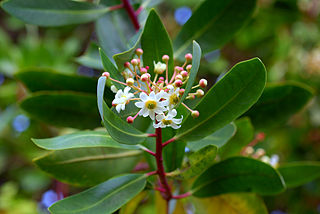
Drimys is a genus of about eight species of woody evergreen flowering plants, in the family Winteraceae. The species are native to the Neotropics, ranging from southern Mexico to the southern tip of South America. They are primitive dicots, associated with the humid temperate Antarctic flora of the Southern Hemisphere, which evolved millions of years ago on the ancient supercontinent of Gondwana. Members of the family generally have aromatic bark and leaves, and some are used to extract essential oils.
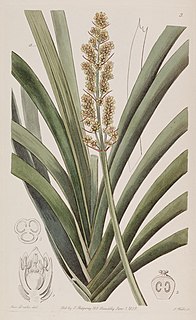
Lomandra, commonly known as mat rushes, is a genus of perennial, herbaceous monocots in the family Asparagaceae, subfamily Lomandroideae. There are 51 species, all of which are native to Australia; two of them also extend into New Guinea and New Caledonia.

Atriplex confertifolia, the shadscale, is a species of evergreen shrub in the family Amaranthaceae, which is native to the western United States and northern Mexico.

Polyscias is a genus of flowering plants in the family Araliaceae. They bear pinnately compound leaves.
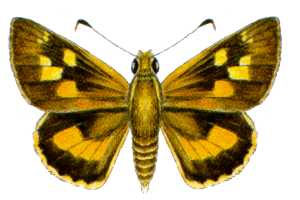
Trapezites eliena, the orange ochre, is a small-sized butterfly endemic to Australia.

Lomandra longifolia, commonly known as spiny-head mat-rush, spiky-headed mat-rush or basket grass, is a perennial, rhizomatous herb found throughout eastern Australia. The leaves are 40 cm to 80 cm long, and generally have a leaf of about 8 mm to 12 mm wide. It grows in a variety of soil types and is frost, heat and drought tolerant. Labillardiere described Lomandra longifolia from a specimen collected in Tasmania.
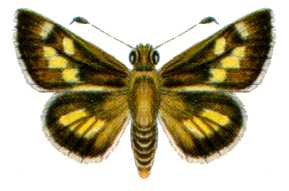
Trapezites lutea, the rare white spot skipper, is a butterfly of the family Hesperiidae. It is found in Australia in the states of New South Wales, Victoria, South Australia and Tasmania.

Trapezites taori, the Taori skipper or sandstone ochre, is a butterfly of the family Hesperiidae. It is found in a small area of the Blackdown Tableland in Queensland, Australia.
Trapezites praxedes, the southern silver ochre skipper, is a butterfly of the family Hesperiidae. It is found in Australia along the coastal plains of New South Wales, southern Queensland and Victoria.

Toxidia peron, the large dingy skipper or dingy grass-skipper, is a butterfly of the family Hesperiidae. It is found in the Australian Capital Territory, New South Wales, Queensland and Victoria.

Grevillea confertifolia, commonly known as Grampians grevillea or dense-leaf grevillea, is a shrub species which is endemic to the Grampians in western Victoria, in Australia.

Lomandra obliqua, known as fish bones and twisted mat-rush, is a small wiry ground covering plant found in eastern Australia. A widespread plant seen on the coast and tablelands. The foliage superficially resembles a fern, but creamy/yellow flowers form on clusters in spring. Leaves are two ranked, somewhat glaucous and twisted.
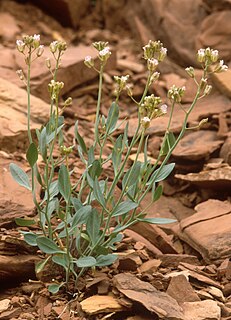
Schoenocrambe barnebyi is a rare species of flowering plant in the mustard family known by the common names Barneby reed-mustard, Syes Butte plainsmustard, and Barneby thelypody. It is endemic to Utah in the United States, where it is known only from Emery and Wayne Counties. It is threatened by habitat degradation and destruction. It is federally listed as an endangered species of the United States.

Lomandra gracilis is a perennial, rhizomatous herb found in New South Wales and Queensland in eastern Australia.

The Burrinjuck Nature Reserve is a protected nature reserve on the south west slopes of New South Wales, Australia. The 5,250-hectare (13,000-acre) reserve is located adjacent to the Burrinjuck Dam, with 5,118 hectares of the reserve located on the northern side of the reservoir, and the remaining 89 hectares located on the southern side of the reservoir to the northeast of Black Andrew Nature Reserve. It includes land formerly managed as the Burrinjuck State Forest and Burrinjuck State Recreation Area.

The Black Andrew Nature Reserve is a protected nature reserve located on the south west slopes of New South Wales, Australia. The 1,559-hectare (3,850-acre) reserve is situated on the southern shore of Burrinjuck Dam on the Murrumbidgee River, an important reservoir for the Murrumbidgee Irrigation Area.

Lomandra filiformis, commonly known as wattle mat-rush, is a tussock forming perennial herb that is native to Australia. It is sparsely tufted, with strap-like leaves and yellow flowers. It grows in dry sclerophyll forest and grassy woodland, usually on well-drained rocky or sandy soils.

The Central Gardens Nature Reserve, also called Central Gardens, is a protected nature reserve located in the western suburbs of Sydney, New South Wales, Australia. Established in 1976, the 12-hectare (30-acre) reserve, garden and fauna and wildlife park is situated in the suburb of Merrylands and is managed by Cumberland Council. The park is regionally important and it attracts visitors outside the Cumberland local government area. The bushland contains remnants of Cumberland Plain Woodland and is approximately 3.5 hectares.
Xylorhiza confertifolia, common name Henrieville woody-aster, is a rare species of flowering plant in the family Asteraceae, known only from Garfield and Kane counties in southern Utah. The common name for the species refers to the Town of Henrieville, in Garfield County. It grows on barren alkaline slopes and in open pinyon-juniper woodlands at elevations of 1,400–2,300 m (4,600–7,500 ft).

Lomandra hystrix, commonly known as green mat-rush, or creek mat-rush, is a perennial, rhizomatous herb found throughout eastern Australia.



















